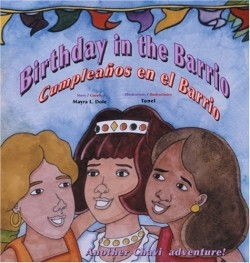Cumpleaos en el Barrio (Birthday in the Barrio)
“You got permission to close the street, right, Chavi?” asks a friend. “UH-OH!” replies Chavi. She forgot to obtain consent from the city of Miami Beach for a huge street party. Without such permission, Lazarita will not have a quinces, the traditional coming-of-age party for Hispanic girls when they turn fifteen.
Chavi, an eight-year-old girl living in a Cuban-American barrio (district or neighborhood), and her friend Rosario want Rosario’s sister, Lazarita, to have a quinces even though her father has lost his job. With help from a friend’s mother, Chavi and Rosario plan a combination quinces party and homeless-shelter fundraiser. The two girls cleverly persuade parents of friends to donate food. Unfortunately, street parties require permission months before the event. Chavi and Rosario worry that they won’t be able to give Lazarita her party; but when the phone rings, things change.
The author, whose birthplace was Cuba, grew up in a Cuban-American community in Florida. The idea for this story (her second published book) sprang from her own fifteenth birthday; she planned a street dance due to tight family finances. Her career pursuits have included landscape designing, hairdressing, drumming, and dancing.
The Cuban-born illustrator, whose pseudonym is Tonel, has exhibited his prolific artwork in various parts of the world, and has received many awards, including fellowships from the John S. Guggenheim Foundation and the Rockefeller Foundation. He has done illustrations for newspapers, magazines, and Dole’s first book, Drum, Chavi, Drum. One of his attention-grabbing cartoon drawings depicts a line of children practicing a dance for the party, many with arms interlinked. Two of these kids have red and purple balloons on strings, reaching to the top of the page.
Picturesque words enliven the text, such as Chavi’s description of arriving at a friend’s house: “I run to Zuli’s house, so fast I BOING into her abuelito’s beach ball belly.” (Abuelito is an endearing term for grandfather.)
The bilingual-English and Spanish-text enables children to improve their less-familiar language. Cuban and standard Spanish words add ethnic flavor to the English part; thus, a glossary would have benefited readers who aren’t acquainted with these words. The compassion that the characters show for people who are homeless promotes good values. This book will familiarize children ages six to nine with Cuban culture, while younger kids will simply enjoy the engaging story.
This lively adventure demonstrates to youngsters that in spite of plans going wrong, hope remains for a memorable quinces-or for whatever one strives to accomplish.
Reviewed by
Norma D. Kellam
Disclosure: This article is not an endorsement, but a review. The publisher of this book provided free copies of the book to have their book reviewed by a professional reviewer. No fee was paid by the publisher for this review. Foreword Reviews only recommends books that we love. Foreword Magazine, Inc. is disclosing this in accordance with the Federal Trade Commission’s 16 CFR, Part 255.

